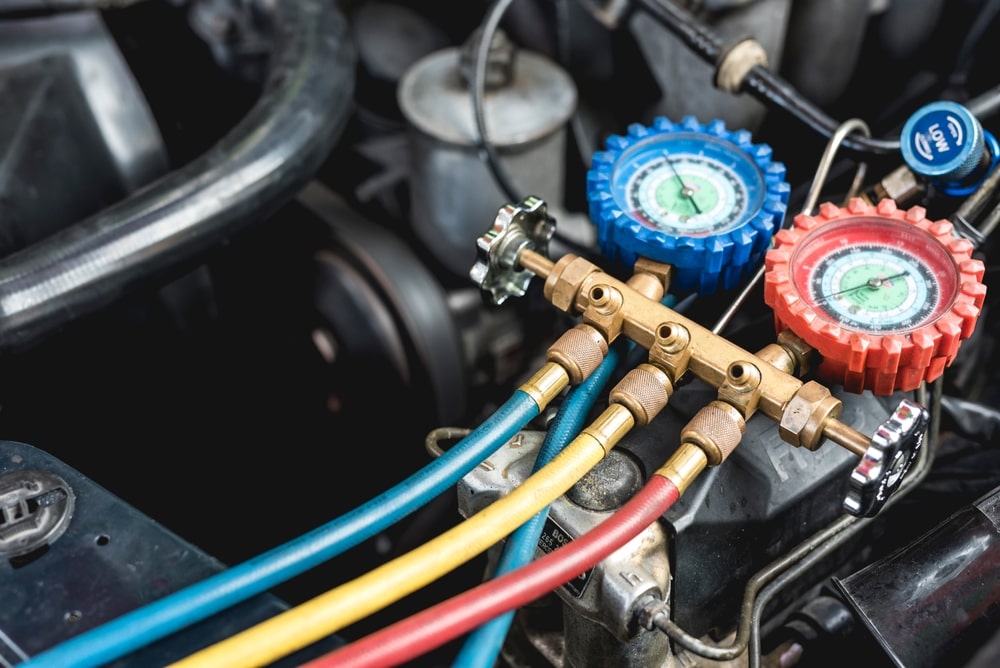Air conditioning is one of the most comfortable amenities in modern cars, and most of us can’t imagine a long, hot drive without it. Unfortunately, cooling systems aren’t indestructible, and most cars eventually need AC repair work – whether it’s normal wear and tear or a major system breakdown.
In this blog, we’ll discuss the leading trends in air conditioning maintenance for late-model cars and classic vehicles. We’ll also discuss what causes air conditioning systems to break down, what warning signs to look for, and how to keep your vehicle’s air conditioning running strong.
Let’s dive in.
How Car Air Conditioning Systems Work
Are you wondering how your car’s AC keeps you so cool and comfortable all the time?
Here’s a quick overview:
- The air conditioning system manipulates refrigerant between its liquid and gaseous state by controlling pressure and temperature within the system.
- As the refrigerant changes between a liquid and a gas, it absorbs the heat and humidity in the vehicle.
- This, in turn, allows the system to blow cool, dry air into the cabin.
Air conditioning systems rely on refrigerants to function correctly. As it turns out, AC refrigerants have also undergone some massive changes in recent years.
Navigating the AC Control Panel
If you’ve ever looked at the AC control panel in a new vehicle, you’ve probably noticed that it’s full of buttons and settings. But what do they all mean?

Here’s your quick guide: (keep in mind – every vehicle is different)
- Power/On-Off Button: This button turns the air conditioning system on and off.
- Fan Speed Control: Adjusts the speed of the blower fan, which determines how fast cool or warm air is circulated throughout the vehicle.
- Temperature Control: Allows you to set the desired cabin temperature. Click up or down or turn left and right to adjust for cooler or warmer air.
- Zone climate control. In cars with dual-zone climate control, the driver and passenger(s) can control their temperature settings in the car. Other cars offer tri-zone climate control, which separates the left and right front passengers, as well as passengers in the second row of the car. Still others provide quad-zone climate control, which makes it possible to control the air conditioning in each seating zone, including the second and third seating rows (if applicable).
- Mode Selector: This button lets you choose where the conditioned air is directed. Common modes include “Face” (blowing air towards the face), “Feet” (directing air towards the floor), and “Defrost” (redirecting air to the windshield to defog or defrost it).
- Recirculation Button: Toggles between recirculating cabin air (helps cool or warm the air faster) or drawing in fresh outside air. (A good button to turn to “recirculate” if you end up behind a diesel truck! Keeps the smell out.)
- AC Button: Activates or deactivates the air conditioning system. When turned on, it cools the air inside the cabin.
- Rear Window Defrost: Turns on the rear window defroster to clear condensation or frost from the rear windshield.
- Rear AC Control: If equipped, this button allows rear passengers to control their own climate settings.
- Auto/Climate Control: In vehicles with automatic climate control, this button lets the system manage temperature, fan speed, and air distribution automatically based on the set temperature.
- Dual Zone Control: Found in some vehicles, it enables the driver and front passenger to set their own temperature preferences.
- Max AC Button: Activates the air conditioning at its maximum cooling capacity.
- Economy Mode: Helps save fuel by reducing AC power when activated.
Remember that the availability and functionality of these buttons may vary depending on the make and model of your vehicle. Always refer to your car’s owner’s manual for specific information on your AC control panel.
A Brief History of AC System Refrigerants
Once upon a time, most automotive air conditioning systems used R-12 (Freon) as a refrigerant.

Freon is a highly effective chlorofluorocarbon (CFC) refrigerant that became popular because it’s not flammable and isn’t poisonous to humans. Unfortunately, it is damaging to the ozone layer, so automotive manufacturers have phased it out in the last thirty years.
Since the 1990s, most manufacturers have used R-134a refrigerant. R-134a is a hydrofluorocarbon (HFC) based refrigerant that’s less damaging to the ozone layer than Freon.
The newest version of this refrigerant is R-1234yf, which is popular because it produces very few greenhouse gasses. R-1234yf is widespread in Europe and, since 2021, has been a requirement in new vehicles.
Today, all new vehicles that come off of the production line must use R1234yf or Tetrafluoropropene refrigerant. These new standards decrease the risks leaking AC systems pose to the environment.
How to Choose an Auto Maintenance Team for AC Repair
While the AC system seems simple, it’s essential to be intentional when you choose a mechanic to work on it.
The reason comes down to changing regulations and the differences between AC systems in late-model and classic cars.
Not only do older cars not use the same refrigerants as modern cars, but the service requirements differ between them.
That’s where DeBroux Automotive comes in.
Our team has invested in all the up-to-date equipment needed to repair AC systems and replace refrigerants in late-model cars and cars manufactured before 2018.
This cutting-edge equipment allows us to provide competitive, comprehensive AC repair services that cater to your unique vehicle.
5 Signs Your Car Needs AC Maintenance

How will you know when it’s time to service your car’s AC?
Here are five telltale signs:
- There’s no cold air
Not surprisingly, the largest, most obvious sign is that your car isn’t blowing cold air.
The issue underlying this symptom may be a blown fuse, failed blower motor, or blocked air intake. No matter what’s causing it, you need to get your car to an auto repair specialist soon!
- It’s making strange noises
If your car’s AC system makes rattling, banging, or humming noises when you turn it on, there’s trouble.
The underlying issue could be a blockage in the system, a worn bearing, a failed compressor clutch or blower motor, or the failure of some other major AC component.
- Your floor feels damp
Sometimes, the moisture that your AC is supposed to be directing out of your car backs up and collects on the passenger’s side floor.
This could indicate a clogged drain line or excess condensation, both of which are issues that require professional AC repair.
- There are strange fluctuations in temperature
If the air from your AC alternates between balmy and chilly, it could indicate an issue like a clogged evaporator or low refrigerant levels.
To fix the problem, get your car to an auto maintenance specialist to have it checked out.
- Strange smells
Strange musty or burning smells from your AC could indicate a problem with its essential components.
If you’ve noticed that things smell funky, it’s time to get your car in for some air conditioning maintenance.
DeBroux Automotive: Reliable, Affordable AC Repairs for All Vehicles

Does your car need air conditioning repair? If so, don’t handle the frustrating side effects of a malfunctioning AC alone.
Nobody deserves to drive around in a hot car when you could be riding in comfort.
For fast, reliable air conditioning maintenance you can count on, contact the team here at DeBroux Automotive.
Whether you drive a classic car or a late-model vehicle, we’re here to help you keep your air conditioning system strong and running well for years to come.
